Foreign News
Philippines feud escalates as lawmakers vote to impeach vice-president

The Philippines’ parliament has voted to impeach Vice-President Sara Duterte following complaints about alleged corruption.
Duterte has been accused of misusing millions of dollars in public funds and threatening to have President Ferdinand ‘Bongbong’ Marcos Jr assassinated.
She has denied the charges and alleged she is the victim of a political vendetta.
The shock move is widely seen as an escalation of the bitter feud between Duterte and Marcos which has kept the nation on edge for months. Both are scions of Philippine political dynasties: she is the daughter of former president Rodrigo Duterte, while he is the son of the late strongman leader Ferdinand Marcos Sr.
A total of 215 out of 306 members of the House of Representatives voted for impeachment, well above the one-third threshold needed for the bill to pass. The bill will now be heard by the 24-member Senate, which will convene as an impeachment court.
If found guilty, Duterte faces removal from her post and would be the first vice-president in Philippine history to be impeached. She is expected to stay in office until the Senate delivers its judgement. A trial date has not been set yet.
Duterte is widely perceived as a potential successor to Marcos, who is ineligible to run again in 2028 as the constitution limits presidents to a single six-year term.
An impeachment would effectively bar her from the presidency, as she would be permanently banned from holding public office.
The move comes ahead of the mid-term elections in May, which will be seen as a referendum for Marcos halfway into his term as well a barometer of public support for Duterte.
Duterte has not commented on the impeachment vote. But her elder brother who represents their hometown of Davao in parliament, Paolo Duterte, said the administration was “treading on dangerous ground” with what he described as a “clear act of political persecution”.
Marcos has also not commented on Duterte’s impeachment. In November, he had said it would be a “waste of time” for lawmakers to impeach her when it has more important work to do.
Since the end of Ferdinand Marcos Sr’s dictatorship and the restoration of democracy in 1986, only one sitting president has been impeached – Joseph Estrada in 2000, for alleged corruption.
But his trial ended without a judgement after a popular revolt forced him from power in January 2001.
Only one impeachment trial made it to a verdict, that of former Supreme Court chief justice Renato Corona, who was convicted of corruption in 2012.
Both the Estrada and Corona impeachment trials were highly politicised and divisive affairs and dragged on for months.
What’s behind the Marcos and Duterte feud?
Duterte and Marcos had presented a picture of unity when they ran for the 2022 elections, calling themselves the “UniTeam”.
But cracks began to appear even before they assumed office, when Duterte asked to handle the defence portfolio in Marcos’ cabinet but instead was made education minister.
Their alliance unravelled further soon after they took power, as they pursued their separate political agendas while differing on crucial fronts such as diplomacy.
Their differences on the Philippines’ relationship to the US and China became more pronounced, as encounters between Philippine and Chinese ships in disputed waters became more frequent.
Marcos has pivoted the Philippines back to the US, reversing the pro-China stance of Duterte’s father.
He has also promised a less violent approach against illegal drug rings, dialling back the elder Duterte’s “war on drugs” that left over 6,000 suspects killed, according to a government count.
The lower house of parliament, where Marcos’s allies hold power, then started scrutinising Duterte’s budget requests, particularly her confidential funds which are not covered by state audits.
In July last year, she resigned from the cabinet.
The feud took a dramatic turn a few months later when, in a late-night livestreamed press conference, Duterte said she “talked to a person” to “go kill” Marcos if she were assassinated.
She later said that she was not plotting to assassinate the President and Marcos had dismissed the threat as a “storm in a teacup”.

[BBC]
Features
Ghana wants more for its cashews, but it’s a tough nut to crack
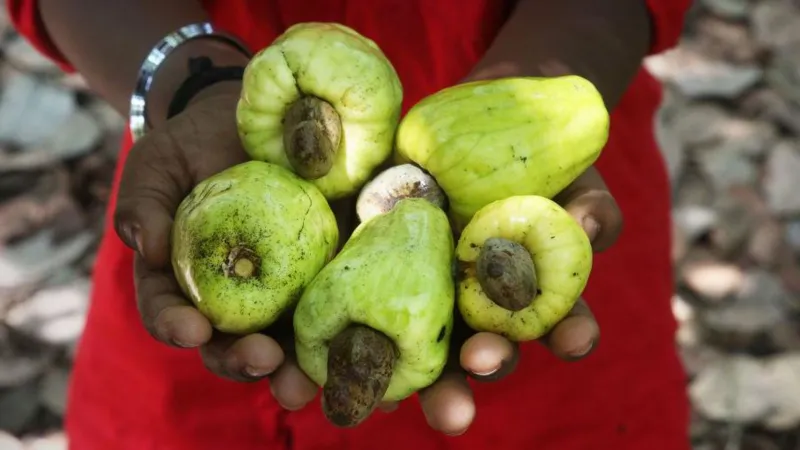
The Accra street vendor looks at me, bemused.
I’m trying to establish how the rather flimsy 30g bag of roasted cashew nuts she’s selling, beside a sweltering highway in Ghana’s capital, costs me the equivalent of about 75 cents (60p).
That’s obviously not a lot of money for me, a visitor from the UK, but I’m amazed at the mark up. The price is at least 4,000% higher than the cost of buying the same weight of raw, unshelled cashews from a Ghanian farmer. “It’s incredible,” I protest. Yet she doesn’t understand my English, or my reasoning.
The price of the nuts was, after all, printed on the packet. And explaining why I thought it was beyond the pale was never going to be easy.
Ghana is the world’s third biggest exporter of unprocessed cashew nuts, behind Ivory Coast in first place, and Cambodia in second.
To produce the crop, around 300,000 Ghanaians make at least part of their living growing cashews.
Nashiru Seydou, whose family have a farm in the country’s north-east, some 500 miles (800km) from Accra, is one of them. He says the work is hard, and unreliable supply chains and volatile wholesale prices make survival difficult. “We are struggling. We can use the sunlight, the fertile land, to create more jobs,” he says. “I’d be happy if the government comes to our aid and helps support our industry.”
He tells me that he currently gets around $50 for a large 100kg sack of unshelled cashews.
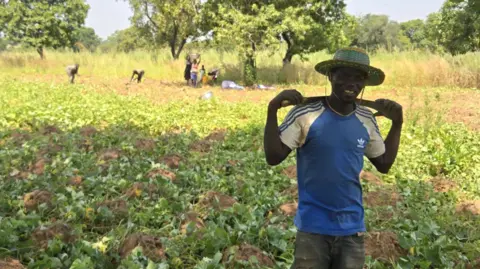
“It’s amazing,” says Bright Simons, an entrepreneur and economic commentator in Accra, who has studied the numbers. “Roasters and retailers buy the nuts from farmers for $500 a tonne, and sell to customers [both at home and abroad] for amounts between $20,000 and $40,000 a tonne.”
As a whole, Ghana grows about 180,000 tonnes of cashews annually. More than 80% is exported, and in raw, unshelled form. This generates some $300m in export revenues, but means that Ghana misses out on the significantly higher returns you get from roasted, ready-to-eat cashews.
Mildred Akotia is one person trying to increase the amount of cashews that are shelled and roasted in Ghana. She is the founder and CEO of Akwaaba Fine Foods, which currently processes just 25 tonnes a year. Ms Akotia denies any suggestion that she and others like her are price-gouging. The packaging and roasting machinery a western business would automatically use in this industry, she says, is out of reach for her because of the high cost of credit in Ghana.
“If you go to a local bank, it will cost you 30% interest to get a loan,” she complains. “As a manufacturer you tell me how large your margins are that you can afford that kind of interest? We’ve had to rely on what we can get: soft loans from relatives and grants from donor agencies.”
She says that this situation is why less than 20% of Ghana’s cashews are processed locally. The bulk are scooped up and exported to big factories in countries like India, Thailand and Vietnam.
Remarkably, some of those packaged nuts are then exported back to Ghana, where they are sold for the same price as domestically roasted cashews. This is despite the 20,000-mile sea freight round trip, and import costs.
It is a similar picture for rice, which is exported to Ghana from Asia and sold at low prices, despite Ghana also growing the crop itself.

Back in 2016 the Ghanaian government experimented with an export ban on raw cashews in order to encourage homegrown processing. However the policy had to be abandoned within a couple of weeks after uproar from farmers and traders.
Without available cheap loans, it wasn’t possible for sufficient new Ghanaian roasters to enter the market. So the price of raw nuts crashed, and many started rotting for want of a buyer.
More recently there has been talk of increased tariffs on raw cashew exports and bans on exporters purchasing cashews directly from farms.
But all these policy interventions miss a key point, according to Mr Simons. A big challenge for local producers, he says, is to work harder on the basics of doing business, and growing their companies.
“In order to be efficient at this, you need scale,” he says, adding that firms need to promote eating cashews to make it more widespread in the country. “You need a lot of a Ghanaians consuming the nuts, not just a small middle class”.
Prof Daron Acemoglu, a Turkish-American economist, agrees that building a strong local market is important for Ghana’s cashew industry. He was one of last year’s winners of the Nobel Memorial Prize in Economic Sciences, for his work on the struggles facing low-income economies, and in particular their home-grown businesses.
Yet he says that the first priority should be improving access to international markets for processed Ghanaian cashews.
“These firms are dealing with workforces that aren’t properly skilled, they have infrastructures that aren’t working, they are constantly in fear of corrupt officials, or rule changes, and also it’s very difficult to reach foreign markets, he says. “They need the foreign market because the domestic market is small, and their own government has very little capacity [to boost it].”
He also wants to see the Ghanaian government improve the network of roads and railways to ease the cost of transportation.
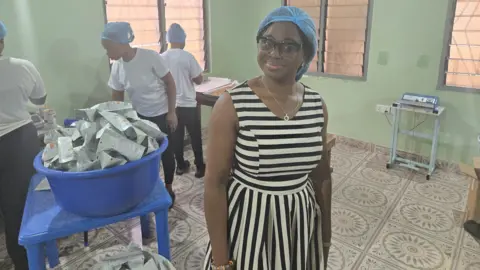
But Mr Simons reckons the onus should now be on Ghanaian businesses themselves, to do the basics to enhance the branding and marketing of cashews. As it is, he says, many of the country’s most enterprising business people are just leaving Ghana for better paid opportunities abroad because of the red tape and cronyism in Ghana are so prohibitive.
“There’s a massive brain drain,” he says. “My theory of why Africa’s economic development has been slow is because we focus too much on the supply side, but the real beauty is in demand, creating a consuming class of cashew-eating enthusiasts, and you don’t have an entrepreneurial class that can create demand transformation.”
He says the same argument applies to Ghana’s other bigger exports, like gold and chocolate, neither of which gets much value-addition within Ghana before getting exported to the West.
Mildred Akotia hopes she might be one of those entrepreneurs to buck the trend. She now wants to build her own logistics arm, to be able to process the cashews direct from the farm gate.
“I have a lot of calls from the UAE, from Canada and America. Currently we can’t meet demand. We can’t get enough kernels to roast. “There’s a ready market both locally and internationally. My branding is good, my marketing is good. My dream is to give a facelift to Ghanaian processed foods.”
[BBC]
Foreign News
Thousands evacuate Santorini as earthquakes strike island
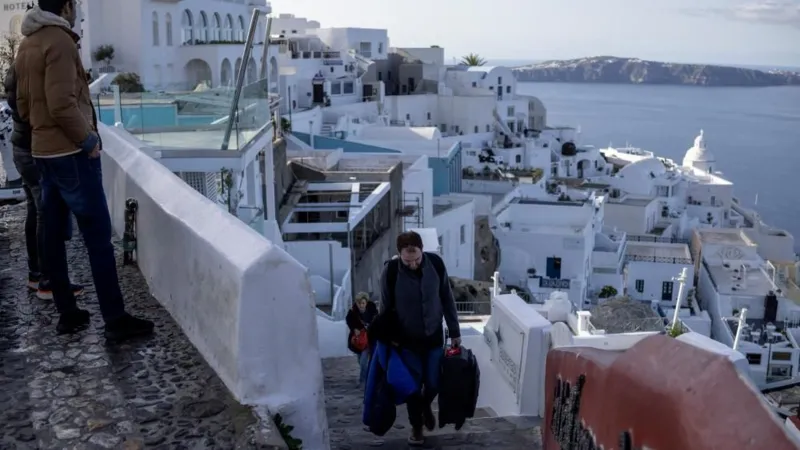
Thousands of residents are fleeing Santorini after hundreds of earthquakes were recorded near the Greek island in the last 48 hours.
About 9,000 people have left the island since Sunday, with additional emergency flights scheduled to leave on Tuesday.
More than 300 earthquakes have been recorded in the past two days near the island, and some experts say tremors could continue for weeks. Authorities have closed schools and warned against large indoor gatherings, but Prime Minister Kyriakos Mitsotakis has urged calm.
Santorini is a popular tourist destination but most of those leaving are locals, as February is outside the peak tourist season.
Dozens of tremors were recorded in the Aegean Sea north-east of Santorini on Tuesday, with a large earthquake measuring magnitude 5 striking mid-afternoon.
Several days of continuous seismic activity has led some residents to sleep in their cars – afraid to spend the night in their homes in case walls or ceilings cave in.
No major damage has been reported on the island so far, but emergency measures are being taken as a precaution.
Hundreds of people queued at a port in the early hours of Tuesday morning to board a ferry leaving for the mainland.
“Everything is closed. No-one works now. The whole island has emptied,” an 18-year-old local resident told Reuters news agency before boarding the vessel.
Local media reports around 6,000 people have left the island by ferry since Sunday, and a further 2,500 to 2,700 passengers will have flown from Santorini to Athens via plane on Monday and Tuesday, according to Aegean Airlines.
The carrier said it had added nine emergency flights to its schedule following a request from the Ministry of Climate Crisis and Civil Protection.
In recent days, an estimated 9,000 people in total have fled Santorini – a small island with a population of just 15,500.
The island welcomes millions of tourists annually, but bookings this time of year are minimal, so local residents and workers make up the majority of evacuees.
Kostas Sakavaras, a tour guide who has lived on Santorini for 18 years, left the island with his wife and children on Monday.
“We considered it’s a better choice to come to the mainland as a precaution,” he told BBC News.
“Nothing has been falling, or anything like that,” he said, adding that the worst part had been the sound. “That’s the most scary part of it,” said Mr Sakavaras, who plans to return home once schools reopen.
Schools are scheduled to stay closed on the island until Friday. Authorities have also warned people to avoid certain areas of the island and empty their swimming pools.
Santorini’s Mayor, Nikos Zorzos, said the island was prepared for seismic activity that “may last many weeks”. The island must approach it “with patience and calm”, he said on Tuesday.
He added that plans were in place to build shelters and provide food for the population should larger tremors emerge.
On Tuesday morning, representatives from the government, armed forces and emergency services met at the Ministry of Climate Crisis and Civil Protection to discuss the situation.
The prime minister will chair a similar meeting on Wednesday.
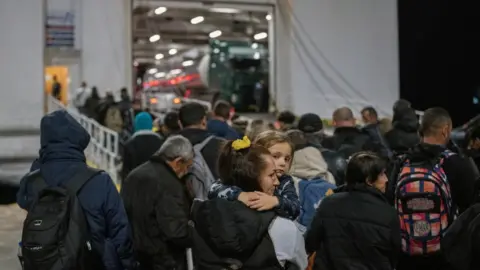
Prime Minister Mitsotakis said on Monday that Greece was working to manage “a very intense geological phenomenon”.
Seismologists consider the recent tremors to be minor, but preventative measures have been put in place in case a larger quake occurs.
Emergency services have warned residents to leave the areas of Ammoudi, Armeni and the Old Port of Fira due to landslides.
The South Aegean Regional Fire Department has been placed on general alert and rescue teams have been dispatched, with crews standing watch by large yellow medical tents on the island.
Concern remains high over the hundreds of earthquakes in the region of the Greek Cyclades Islands, with scientists rapidly analysing data to better understand the phenomenon.
Most of the strongest earthquakes are originating from an area around the tiny islet of Anydros, north-east of Santorini.
With seismic activity remaining intense in the region, scientists are on alert not only for Santorini, but also for Amorgos, Anafi and Ios.
In the event of a larger earthquake, the main issue is the resistance of buildings, especially in Santorini, due to the peculiarities of the soil.
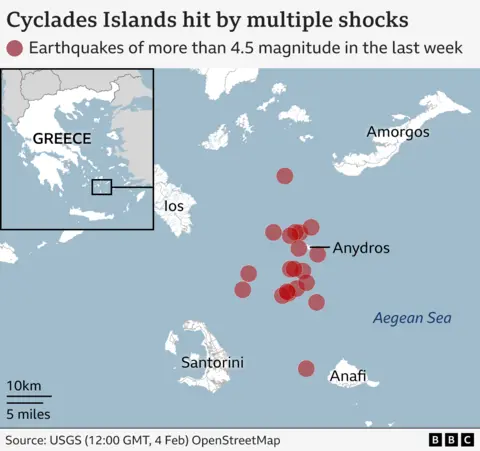
Foreign News
Major highway partly collapses as Australian floods worsen
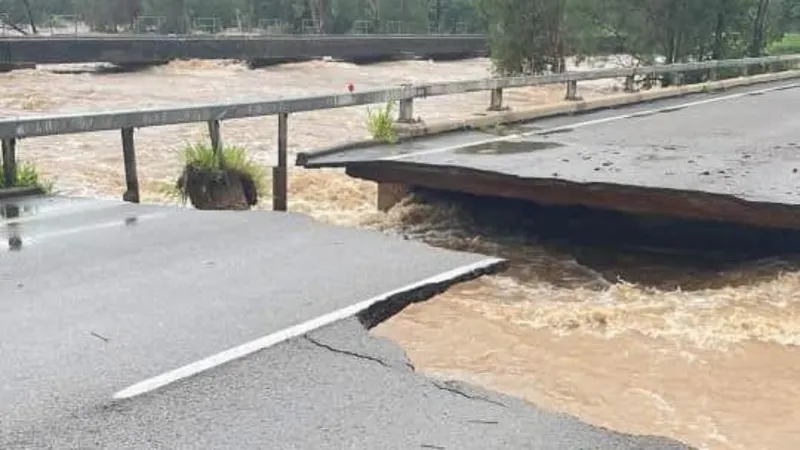
Sections of a major Australian highway have been washed away, as flooding in Queensland worsens.
The torrential rainfall in the state’s north has claimed one life so far and forced thousands to flee their homes, with communities in Townsville, Ingham, and Cardwell among the hardest hit.
“Record” downpours are set to continue, authorities say, with parts of the region already experiencing more than 1.3m (4.2ft) of rain since Saturday, causing dams and rivers to overflow.
Prime Minister Anthony Albanese – who was briefed about the response efforts on Monday – said that the disaster had bought out “the best of Australians”.
“I’ve seen Australians helping one another in their time of need,” he wrote on X, adding that the “threat from floodwaters” would persist in affected areas for days.
Efforts to get rescue teams to some of the worst-hit towns and cities have been hampered due to the collapse of parts of the Bruce Highway – a major piece of infrastructure connecting Brisbane to the state’s regional centres which is longer than the road between London and Warsaw.
The Queensland Trucking Association told the ABC that the damage – which caused a bridge to cave in – could add an extra 700km (434 miles) to key driving routes, slowing down the delivery of critical supplies.
Queensland’s Premier David Crisafulli offered his condolences to the “tight-knit” town of Ingham – where a 63-year-old woman died in a rescue attempt after a State Emergency Service (SES) dinghy capsized on Sunday.
“We are deeply sorry for their loss,” he told reporters, adding that he would travel to north Queensland later Monday.
He also urged all residents located in the so-called “black-zone” of the floods – which includes six Townsville suburbs – to not return home, due to the ongoing threat posed by the nearby Ross River.
Australia’s Bureau of Meteorology said the area received six months of rainfall in three days, while the Townsville Local Disaster Management Group warned that 2,000 homes could be inundated, some up to the second floor, as water levels rise.
The persistent deluge – which is gradually easing according to weather reports – has swollen waterways throughout the region. Major flood warnings remain in place for communities along the Hebert, Ross, Bohle, Horton, and Upper Burdekin rivers.
Emergency responders have continued working around the clock, with the SES receiving 480 calls for help overnight Sunday into Monday and performing 11 swift water rescues. Widespread power outages continue to be reported though, making it impossible for some communities to call for assistance.
SES Deputy Commissioner Shane Chelepy urged people to stay vigilant and check on their neighbours wherever possible. He added that some 400 people were now being housed in evacuation centres across Townsville, Ingham, and Cardwell.
Located in the tropics, north Queensland is vulnerable to destructive cyclones, storms, and flooding.
But climate scientists have warned that warmer oceans and a hotter planet are creating the conditions for more intense and frequent extreme rainfall events.
Meteorologists say the current floods could be the worst to hit the region in more than 60 years.
-

 News4 days ago
News4 days agoNew Bangalore-Jaffna flights in the works
-

 Features6 days ago
Features6 days agoA singular modern Lankan mentor – Part I
-

 Editorial7 days ago
Editorial7 days agoRegime changes and scandals
-
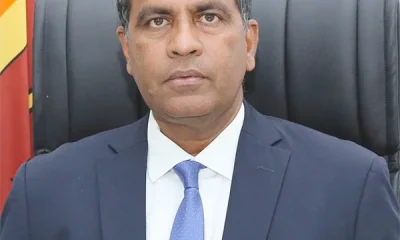
 News7 days ago
News7 days agoCustoms cleared thousands of ‘marked’ containers sans examination beginning last year
-

 News2 days ago
News2 days agoCID questions top official over releasing of 323 containers
-
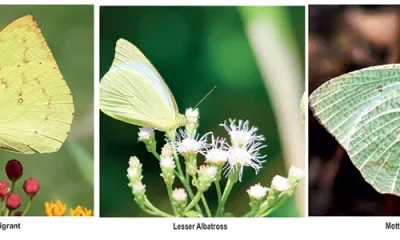
 Features7 days ago
Features7 days agoButterfly migration fading away
-

 News4 days ago
News4 days agoCardinal says ‘dark forces’ behind Easter bombs will soon be exposed
-
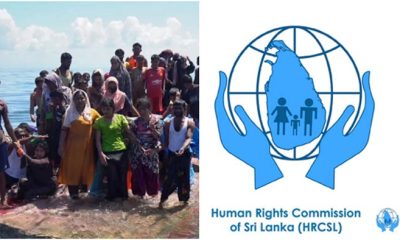
 News4 days ago
News4 days agoHRCL reports on Rohingya asylum seekers











